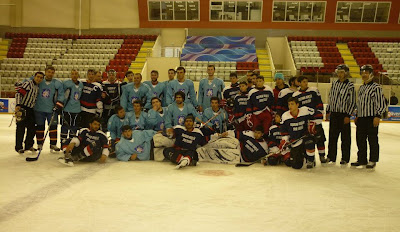Black Sea Cup:
Erzurum Gençlikspor & Georgia
- Technique
- Type
- Think & Execute Off Puck
- Timing
The best players maintain good technique at all times. Good technique must be emphasized on every pass.
- Cup, Push, Point
The passer must choose the right type of pass. The player must choose when to use touch passes, first and second touch skating and passing. Players must choose when to make short or long pass. Players must choose when to pass to stick, space or use no space play. Players need to know when to use the boards to make a pass or clear.
Types of Passes
- Forehand
- Backhand
- 1 touch, 2 touch, 3 touch
- 1 time
- Saucer
- Snap
- Slap
- Use of boards
Each player must be "thinking off the puck" and working on being in position to receive a pass. Players need to work on things like: Am I calling for the puck when open? Can I see the puck? Am I in the best place for a pass? How can I give my teammate an option? Can I create space for others? The best players are always thinking and executing "OFF the Puck".
The 4th "T" is for timing. Both the player with the puck and without the puck need to work on timing skills. Timing is everything in hockey. Arrive a little to fast, a little to slow and the play results in a turnover. The player with the puck must choose the right pace of the pass. Pass to hard it arrives to fast. Pass to slow, it behind the receiver or the puck is intercepted.
- Control Skate, Communicate & Accelerate
Coaches must work on the "Four T's" if they want to improve their team play. When players master the three T's, puck handling, passing, scoring and tactics will all improve.
Related Videos & Teaching Points:
Power Thoughts:
I skate to where the puck is going to be, not to where it has been - Wayne Gretzky
A winner never whines.
-Paul Brown

























